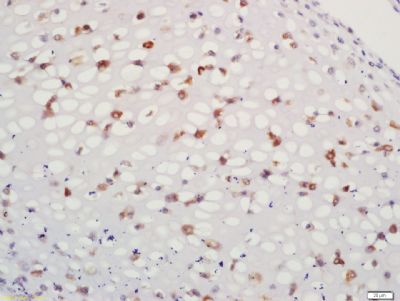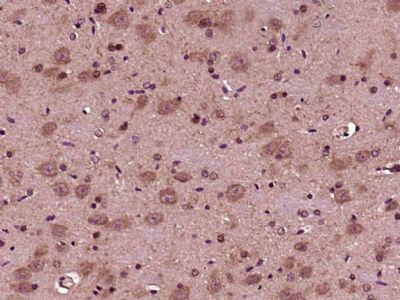ACAN Polyclonal Antibody
Purified Rabbit Polyclonal Antibody (Pab)
- SPECIFICATION
- CITATIONS
- PROTOCOLS
- BACKGROUND

Application
| IHC-P, IHC-F, IF |
|---|---|
| Primary Accession | P16112 |
| Reactivity | Rat, Pig, Dog, Bovine |
| Host | Rabbit |
| Clonality | Polyclonal |
| Calculated MW | 99 KDa |
| Physical State | Liquid |
| Immunogen | KLH conjugated synthetic peptide derived from mouse ACAN |
| Isotype | IgG |
| Purity | affinity purified by Protein A |
| Buffer | 0.01M TBS (pH7.4) with 1% BSA, 0.02% Proclin300 and 50% Glycerol. |
| SUBCELLULAR LOCATION | Secreted, extracellular space, extracellular matrix. |
| SIMILARITY | Belongs to the aggrecan/versican proteoglycan family.Contains 1 C-type lectin domain.Contains 1 EGF-like domain.Contains 1 Ig-like V-type (immunoglobulin-like) domain.Contains 4 Link domains.Contains 1 Sushi (CCP/SCR) domain. |
| SUBUNIT | Interacts with FBLN1. Interacts with COMP. |
| Post-translational modifications | Contains mostly chondroitin sulfate, but also keratan sulfate chains, N-linked and O-linked oligosaccharides. The release of aggrecan fragments from articular cartilage into the synovial fluid at all stages of human osteoarthritis is the result of cleavage by aggrecanase. |
| DISEASE | Spondyloepiphyseal dysplasia type Kimberley (SEDK) [MIM:608361]: Spondyloepiphyseal dysplasias are a heterogeneous group of congenital chondrodysplasias that specifically affect epiphyses and vertebrae. The autosomal dominant SEDK is associated with premature degenerative arthropathy. Note=The disease is caused by mutations affecting the gene represented in this entry.Spondyloepimetaphyseal dysplasia aggrecan type (SEMD-ACAN) [MIM:612813]: A bone disease characterized by severe short stature, macrocephaly, severe midface hypoplasia, short neck, barrel chest and brachydactyly. The radiological findings comprise long bones with generalized irregular epiphyses with widened metaphyses, especially at the knees, platyspondyly, and multiple cervical-vertebral clefts. Note=The disease is caused by mutations affecting the gene represented in this entry.Osteochondritis dissecans short stature and early-onset osteoarthritis (OD) [MIM:165800]: A type of osteochondritis defined as a separation of cartilage and subchondral bone from the surrounding tissue, primarily affecting the knee, ankle and elbow joints. It is clinically characterized by multiple osteochondritic lesions in knees and/or hips and/or elbows, disproportionate short stature and early-onset osteoarthritis. Note=The disease is caused by mutations affecting the gene represented in this entry. |
| Important Note | This product as supplied is intended for research use only, not for use in human, therapeutic or diagnostic applications. |
| Background Descriptions | Aggrecan is a member of a family of large, aggregating proteoglycans (also including versican, brevican and neurocan) which is found in articular cartilage. Aggrecan is composed of three major domains: G1, G2, and G3. Between the G1 and G2 domains there is an interglobulin region (IGD). The IGD region is the major site of cleavage by specific proteases like metalloproteinases (MMPs) and aggrecanase. Aggrecan cleavage has been associated with a number of degenerative diseases including rheumatoid arthritis and osteoarthritis. There is evidence that this family of proteoglycans modulates cell adhesion, migration, and axonal outgrowth in the CNS. |
| Gene ID | 176 |
|---|---|
| Other Names | Aggrecan core protein, Cartilage-specific proteoglycan core protein, CSPCP, Chondroitin sulfate proteoglycan core protein 1, Chondroitin sulfate proteoglycan 1, Aggrecan core protein 2, ACAN, AGC1, CSPG1, MSK16 |
| Target/Specificity | Restricted to cartilages. |
| Dilution | IHC-P=1:100-500,IHC-F=1:100-500,IF=1:100-500 |
| Storage | Store at -20 ℃ for one year. Avoid repeated freeze/thaw cycles. When reconstituted in sterile pH 7.4 0.01M PBS or diluent of antibody the antibody is stable for at least two weeks at 2-4 ℃. |
| Name | ACAN |
|---|---|
| Synonyms | AGC1, CSPG1, MSK16 |
| Function | This proteoglycan is a major component of extracellular matrix of cartilagenous tissues. A major function of this protein is to resist compression in cartilage. It binds avidly to hyaluronic acid via an N-terminal globular region. |
| Cellular Location | Secreted, extracellular space, extracellular matrix {ECO:0000250|UniProtKB:P07898} |
| Tissue Location | Detected in fibroblasts (at protein level) (PubMed:36213313). Restricted to cartilage (PubMed:7524681) |

Thousands of laboratories across the world have published research that depended on the performance of antibodies from Abcepta to advance their research. Check out links to articles that cite our products in major peer-reviewed journals, organized by research category.
info@abcepta.com, and receive a free "I Love Antibodies" mug.
Provided below are standard protocols that you may find useful for product applications.
If you have used an Abcepta product and would like to share how it has performed, please click on the "Submit Review" button and provide the requested information. Our staff will examine and post your review and contact you if needed.
If you have any additional inquiries please email technical services at tech@abcepta.com.













 Foundational characteristics of cancer include proliferation, angiogenesis, migration, evasion of apoptosis, and cellular immortality. Find key markers for these cellular processes and antibodies to detect them.
Foundational characteristics of cancer include proliferation, angiogenesis, migration, evasion of apoptosis, and cellular immortality. Find key markers for these cellular processes and antibodies to detect them. The SUMOplot™ Analysis Program predicts and scores sumoylation sites in your protein. SUMOylation is a post-translational modification involved in various cellular processes, such as nuclear-cytosolic transport, transcriptional regulation, apoptosis, protein stability, response to stress, and progression through the cell cycle.
The SUMOplot™ Analysis Program predicts and scores sumoylation sites in your protein. SUMOylation is a post-translational modification involved in various cellular processes, such as nuclear-cytosolic transport, transcriptional regulation, apoptosis, protein stability, response to stress, and progression through the cell cycle. The Autophagy Receptor Motif Plotter predicts and scores autophagy receptor binding sites in your protein. Identifying proteins connected to this pathway is critical to understanding the role of autophagy in physiological as well as pathological processes such as development, differentiation, neurodegenerative diseases, stress, infection, and cancer.
The Autophagy Receptor Motif Plotter predicts and scores autophagy receptor binding sites in your protein. Identifying proteins connected to this pathway is critical to understanding the role of autophagy in physiological as well as pathological processes such as development, differentiation, neurodegenerative diseases, stress, infection, and cancer.



